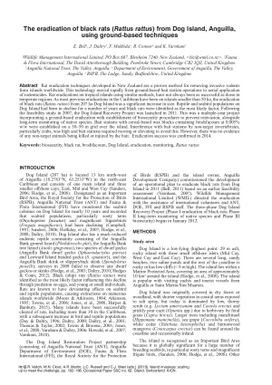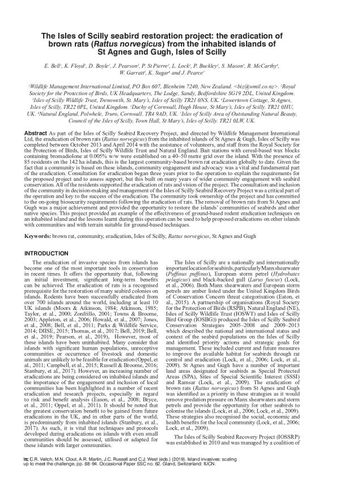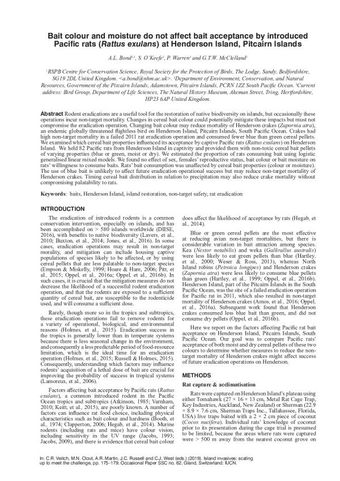The eradication of black rats (Rattus rattus) from Dog Island, Anguilla, using ground-based techniques
- Description:
- Rat eradication techniques developed in New Zealand are a proven method for removing invasive rodents from islands worldwide. This technology moved rapidly from ground-based bait station operations to aerial application of rodenticides. Rat eradications on tropical islands using similar methods, have not always been as successful as those in temperate regions. As most previous eradications in the Caribbean have been on islands smaller than 50 ha, the eradication of black rats (Rattus rattus) from 207 ha Dog Island was a significant increase in size. Reptile and seabird populations on Dog Island had been in decline for a number of years and black rats were identified as the most likely factor. Following the feasibility study in 2007, the Dog Island Recovery Project was launched in 2011. This was a multiple-year project incorporating a ground-based eradication with establishment of biosecurity procedures to prevent reinvasion, alongside long-term monitoring of native species. Bait stations with cereal-based wax blocks containing brodifacoum at 0.005% w/w were established on a 3050 m grid over the island. Interference with bait stations by non-target invertebrates, particularly crabs, was high and bait stations required moving or elevating to avoid this. However, there was no evidence of any non-target animals being killed or injured by the bait. Eradication success was confirmed in 2014.
- Display date:
- 2019
- Collections:
- Secretariat of the Pacific Regional Environment Programme (SPREP)
- Publisher:
- Secretariat of the Pacific Regional Environment Programme (SPREP)
- Content partner:
- Secretariat of the Pacific Regional Environment Programme (SPREP)
- Availability:
- Not specified
-
Copyright status: All rights reservedFind out more about what you are able to do with this itemThis item is all rights reserved, with means you'll have to get permission from Secretariat of the Pacific Regional Environment Programme (SPREP) before using it. For more information, please see our use and reuse page.What can I do with this item?Non-infringing useNZ copyright law does not prevent every use of a copyright work, and this item may be hosted by an international institute or organisation. You should consider what you can and cannot do with a copyright work.No sharingYou may not copy and/or share this item with others without further permission. This includes posting it on your blog, using it in a presentation, or any other public use.No modifyingYou are not allowed to adapt or remix this item into any other works.No commercial useYou may not use this item commercially.
Related items
Welcome and warm Pasifik greetings
The information on this site has been gathered from our content partners.
The names, terms, and labels that we present on the site may contain images or voices of deceased persons and may also reflect the bias, norms, and perspective of the period of time in which they were created. We accept that these may not be appropriate today.
If you have any concerns or questions about an item, please contact us.


